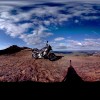Easter Island statues reveal their secret—with help from a satellite
High-resolution satellite imaging has revealed how the iconic statues have moved to every part of the island.
The massive stone statues of Easter Island—called Rapu Nui by its inhabitants—have mystified us ever since Europeans first landed on the island in 1722. By then, the story of the 887 statues—or Moai in the Rapa Nui language—had been lost from the collective memory of the Rapu Nui people.

Why had the islanders’ ancestors expended so much effort on the Moai, which are as tall as forty feet and weigh as much as 75 tonnes, the equivalent of twenty mid-sized cars? And how had so few people on a remote island—the nearest inhabited land, Pitcairn Island with around 50 residents, is 2,075 kilometres away—moved the Moai as far as 18 kilometres over rugged terrain without even large animals to help?

The first question was easy to answer. Polynesian peoples settled Rapu Nui sometime between 700 and 1,100 AD. Throughout the Polynesian culture at that time, deceased relatives were believed to have an influence on the living. The Moai represent ancestors watching over their descendants, which is why so much effort and importance was invested in them, and why almost all face inland instead of seaward.
Finding the paths
A definitive answer to the second question has been hard to find—and some suggestions have been flat out bizarre, such as the claim of once-popular author Erich von Daniken that the Moai are the handiwork of aliens. Other highly implausible theories include the Moai being propelled through the air by eruptions at the volcanic stone quarry where they were carved, or being created on site by the Rapa Nui people molding clay.
One of the challenges archaeologists faced was that few roads led from the quarry to the ceremonial platforms, called ahu, where the Moai were erected. The last of the Moai were carved around five hundred years ago, so it is likely that natural vegetation regrowth and human activity had covered up many of the Moai transport roads.
In 2005, archeologists P. Lipo and Terry L. Hunt from the University of Hawaii set out to test this hypothesis using panchromatic images—black-and-white photographs sensitive to all the wavelengths of visible light—taken by the QuickBird commercial satellite over Rapu Nui in December 2001 and February 2002.
Rapu Nui is very small—about 17 square kilometres, one-quarter the size of Manhattan—making it easy to meticulously examine the satellite images, which cover 85% of the island’s surface at a resolution pixel size of 70 centimetres.
Dr. Lipo and Dr. Hunt were looking for several signs of ancient roads—changes in vegetation caused by compacted soil, depressions filled with deposits of soil and gravel from seasonal runoff streams, built-up banks, erosion patterns and otherwise inexplicable shadows.

Satellite image of ancient road section (A) with circular patterns (6-8m) visible on the north side (B).
These features showed up on the images as grayscale variations. Backed up by surveys in the field, the images identified close to 32 kilometres of ancient Moai roads radiating like spokes from the Rano Raraku quarry to every part of the island. Recent additional image analysis by archaeologist Gabriel Wofford, also from the University of Hawaii, has identified possibly even more ancient roads, although these still need to be verified with field surveys.
Walk this way
The network of newly revealed ancient roads led Dr. Lipo and Dr. Hunt to consider the assertion among the Rapu Nui, passed down for generations, that the Moai had been “walking giants.” The archeologists devised a method in which small teams use ropes to rock the Moai from side to side, which moves it forward in step-like motions, while a third team behind the Moai keep it from falling backward. The Moai seem to be built for this transport method—they lean slightly when stood upright, making it relatively easy to keep them moving forward.
The future of archaeology
The University of Hawaii team is part of a growing community of space archaeologists; specialists who use satellite and remote sensing technology to find ancient sites or features not visible to the naked eye.
For example, Dr. Jason Ur, an archaeologist at Harvard University, surveyed Iraq and with his colleagues identified close to 1,200 potential sites using images taken by spy satellites in the 1960s. And Sarah Parcak, a professor at the University of Alabama at Birmingham, used satellite data to identify potential sites of 17 Egyptian pyramids, 1,000 forgotten tombs, and 3,100 lost settlements.
Remote sensing is especially useful for areas too dangerous for physical exploration or traditional digs. Archaeologist Damian Evans, who heads up the University of Sydney’s Cambodian research base, and William Saturno, assistant professor of archaeology at Boston University, used space archaeology to survey Lingapura, the ancient capital of the Angkorian empire in northwestern Cambodia. In the 1970s, the Khmer Rouge buried thousands of landmines throughout the site. As this technology advances, so will our knowledge of sites long forgotten.



 Space Archaeology
Space Archaeology  “The World Isn’t Flat, It’s Panoramic”
“The World Isn’t Flat, It’s Panoramic” 